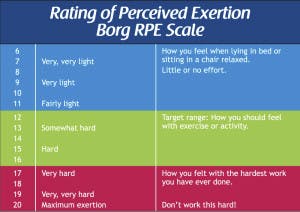We’re all getting older and unfortunately aging does come with some challenges. These include decreased bone density and lean (muscle) mass along with an increase in body fat and a higher risk for cardiovascular disease. Some of these changes are intensified in women after menopause. Many people are also exercising or being active less often resulting in declines in balance, coordination, and strength. While that doesn’t sound very encouraging, fortunately there is something you can do to mitigate these negative side effects of aging!
Exercise (including cardiovascular training, strengthening, and flexibility) can make serious positive changes in all of the areas listed above!
Most exercise recommendations talk about the intensity with which you are exercising. This can sometimes be confusing so let’s make it simple! There are two main ways to gauge the intensity of your exercise – as a percentage of your maximum heart rate (HR max) and the rating of perceived exertion (RPE).
RPE: This is the easiest to determine. No calculation required, it’s purely based on how hard you determine you’re working. This should be in the somewhat hard to hard range as seen. Below this is too easy, but working into the very hard range can lead to injury and may deter you from exercise!

Courtesy of: https://www.zentofitness.com/treadmill-tabata-workout-9-rate-of-perceived-exertion-rpe/
HR max: This calculation determines your maximum heart rate. You can use this to then determine your exercise intensity as a percentage of this maximum heart rate. The higher the percentage, the higher the intensity. Moderate intensity is usually between 50-60% of your HR max. This range matches pretty well with your interpretation of somewhat hard above, but it does depend on each persons interpretation of how hard they’re working! You can use a heart rate monitor or take your pulse to figure out your heart rate!
HR max = 220 – (your age)
Example: 55 year old HR max = 220 – 55 = 165 beats per minute (bpm)
Moderate exercise intensity: 165 x 50% = 82.5bpm
Exercise recommendations from the American College of Sports Medicine (ACSM):
Aerobic (cardiovascular endurance): 2-3 days per week for >30 min at a moderate intensity (RPE of 11-13, 50-60% HR max)
Examples: walking, jogging, swimming, dancing
Strengthening (resistance training): 2-3 days per week; choose 8-10 exercises and perform 1-3 sets of 10-15 repetitions (the last 1-2 should be hard to perform)
Examples: body weight exercises, resistance bands, circuit training, free weights, weight machines
Flexibility (stretching): >2 days per week performing 8-10 stretches for 10 minutes. Light intensity (very slight discomfort), hold each stretch for 30+ seconds and repeat up to 3 times
Examples: major muscle groups – calf, quadricep, hamstring, shoulders
Those are the keys to modifying your exercise as you age to maintain a healthy life. Remember, you can’t change your chronological age, but you can change your physiological (you’re body’s make up) age!
Happy Exercising!
– Erin Bell, PT, DPT, Doctor of Physical Therapy
Resources:
https://www.nia.nih.gov/health/publication/exercise-physical-activity/introduction
https://well.blogs.nytimes.com/2015/04/15/the-right-dose-of-exercise-for-a-longer-life/?smid=fb-nytimes&smtyp=cur&bicmp=AD&bicmlukp=WT.mc_id&bicmst=1409232722000&bicmet=1419773522000&_r=2
https://www.sciencedirect.com/science/article/pii/S2095254614000386
